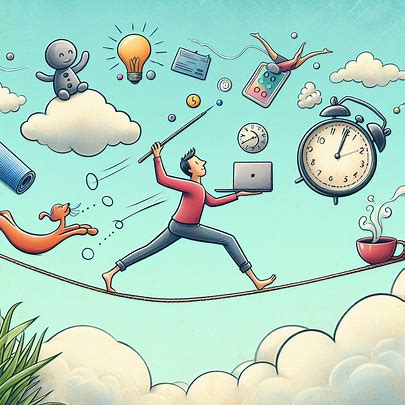Finding Harmony: A Deep Dive into Work-Life Balance
![]()
Work-life balance isn’t a rigid 50/50 split between work and personal time, but rather finding a sustainable equilibrium where you can fulfill work obligations while having time and energy for personal well-being and the things that matter to you. By prioritizing well-being and activities that bring you joy, you can achieve a fulfilling and successful life, both personally and professionally.
Work-life balance. It’s a term we hear often, but achieving it can feel like an elusive dream. In today’s fast-paced world, the lines between work and personal lives can easily blur. Long hours, constant connectivity, and demanding schedules can leave us feeling burnt out and depleted.
But what exactly is work-life balance? It’s not about creating a rigid 50/50 split between work and personal time. It’s about finding a sustainable equilibrium where you can fulfill your work obligations while also having the time and energy to nurture your personal well-being and the things that matter to you.

Here’s a deeper look into the importance of work-life balance and how to achieve it:
Why is Work-Life Balance Important?
Maintaining a healthy work-life balance isn’t a luxury, it’s a necessity. Here’s why:
- Improved well-being: Chronic work stress can lead to a cascade of negative consequences, impacting your physical and mental health. Work-life balance allows you to prioritize activities that reduce stress, improve sleep, and boost your overall well-being.
- Enhanced productivity: When you’re well-rested and rejuvenated, you bring a sharper focus and more energy to your work. This translates into increased productivity and better work quality.
- Stronger relationships: Dedicating time to loved ones fosters stronger connections and a sense of belonging. Work-life balance ensures you’re present and engaged in your personal life, nurturing the relationships that matter most.
- Reduced burnout: Feeling constantly overloaded can lead to burnout, a state of emotional exhaustion and cynicism towards work. Work-life balance helps prevent burnout by creating space for activities that bring you joy and a sense of accomplishment outside of work.

Creating Your Work-Life Balance Blueprint
There’s no one-size-fits-all approach to work-life balance. What works for your colleague might not work for you. The key is to identify your priorities and create strategies that work within your unique circumstances. Here are some steps to get you started:
- Self-reflection: Take a step back and assess your current situation. How much time are you dedicating to work compared to personal pursuits? What are your energy levels like throughout the day? Are you feeling fulfilled in both areas of your life?
- Define your priorities: What are the things that are most important to you outside of work? Is it spending time with family, pursuing hobbies, or maintaining physical fitness? Once you know your priorities, you can start allocating time for them.
- Set boundaries: Establishing clear boundaries between work and personal life is crucial. This could involve setting specific work hours, sticking to them, and avoiding checking work emails outside of those times.
- Time management: Learn effective time management techniques to maximize your productivity during work hours. This allows you to accomplish more in a shorter time, freeing up space for personal pursuits.
- Learn to say no: Don’t be afraid to politely decline additional work responsibilities if it starts to affect your work-life balance. It’s okay to prioritize your well-being.
- Delegate and automate: If possible, delegate tasks at work or find ways to automate repetitive processes. This frees up time for more important activities.
- Disconnect and recharge: Schedule regular breaks throughout the workday and take time to disconnect completely after work hours. This allows you to de-stress and recharge your batteries.

Remember, work-life balance is an ongoing journey, not a destination. There will be times when work demands more of your attention, and that’s okay. The key is to be mindful, make adjustments as needed, and strive to create a sustainable balance that works for you in the long run. By prioritizing your well-being and the things that bring you joy, you can achieve a fulfilling and successful life, both personally and professionally.



